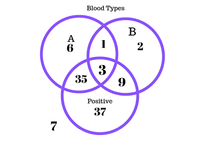
A First Course in Probability (10th Edition)
10th Edition
ISBN: 9780134753119
Author: Sheldon Ross
Publisher: PEARSON
expand_more
expand_more
format_list_bulleted
Question
The blood-typing system is based on the presence or absence of antigens. A person with antigen A has blood type A. A person with antigen B has blood type B, and a person with both antigens has the blood type AB. If there are no antigens, then the blood type is O. In addition, blood types are also identified as Rh-positive or Rh-negative based on a different antigen. What is the probability that a person has the antigens A or B?

Transcribed Image Text:The image is a Venn diagram illustrating the distribution of blood types within a group. The diagram consists of three circles, intersecting with one another, each labeled with a blood type category: A, B, and Positive. Here's a detailed explanation of the diagram:
1. **Circle A**: Represents individuals with blood type A.
- Contains the numbers 6, 35, 3, and 1.
2. **Circle B**: Represents individuals with blood type B.
- Contains the numbers 2, 9, 3, and 1.
3. **Circle Positive**: Represents individuals with a positive Rh factor.
- Contains the numbers 37, 35, 9, 3, and 1.
**Intersections**:
- The intersection of circles A and B contains the number 1, indicating individuals with both blood types A and B.
- The intersection of circles A and Positive contains the numbers 35 and 3, indicating individuals with blood type A and a positive Rh factor.
- The intersection of circles B and Positive contains the numbers 9 and 3, indicating individuals with blood type B and a positive Rh factor.
- The intersection of all three circles contains the number 3, indicating individuals with blood types A, B, and a positive Rh factor.
**Outside the Circles**:
- The number 7 is outside the circles, representing individuals who do not fall into any of these categories.
Expert Solution
arrow_forward
Step 1
.jpg)
Trending nowThis is a popular solution!
Step by stepSolved in 2 steps with 2 images

Knowledge Booster
Similar questions
- If a seed is planted, it has a 65% chance of growing into a healthy plant. If 10 seeds are planted, what is the probability that exactly 1 doesn't grow?arrow_forwardThe American Red Cross says that about 45% of the U.S. population has Type O blood, 40% Type A, 11% Type B, and 4% Type AB Round your answers to the nearest hundredth, O.XX. a. What is the probability that the next blood donor who enters a donation center has Type O or Type A blood? type your answer... b. What is the probability that the next three blood donors all have Type O blood? type your answer... Previousarrow_forwardIf the probability of having type AB Blood is 0.517, what is the probability that in a group of four people, all four have type AB Blood?arrow_forward
- A company requires all job applicants to undergo drug testing for employment. If the applicant has used drugs the test has a 90% chance of a positive result. If the applicant has not used drugs the test has an 85% chance of a negative result. 4% of all applicants have used drugs. If an applicant has a positive test, what is the probability he or she has actually used drugs?arrow_forwardWith regards to a particular gene, the percentage of genotypes AA, Aa, and aa in a particular population are respectively, 60%, 30%, and 10%. Furthermore, the percentages of these genotypes that contract a certain disease are respectively. 1%, 5% and 20%. If a person does contract the disease, what is the probability that the person is of genotype AA?arrow_forwardA certain typing agency employs two typists. The average number of errors per article is 1.4 when typed by the first typist and 2.4 when typed by the second. If your article is equally likely to be typed by either typist, find the probability that it will have no errors.arrow_forward
- A drawer contains a large number of batteries - 70% areEnergizer batteries and 30% are Duracell batteries.Suppose that 20% of the Energizer batteries are deadand 40% of the Duracell batteries are dead. If yourandomly select a battery from the door and it is dead,what is the probability it is a Duracell batteryarrow_forwardEach of two parents has the genotype blue/brown, which consists of the pair of alleles that determine eye color, and each parent contributes one of those alleles to a child. Assume that if the child has at least one blue allele, that color will dominate and the child's eye color will be blue. a. List the different possible outcomes. Assume that these outcomes are equally likely. b. What is the probability that a child of these parents will have the brown/brown genotype? c. What is the probability that the child will have blue eye color?arrow_forward
arrow_back_ios
arrow_forward_ios
Recommended textbooks for you
 A First Course in Probability (10th Edition)ProbabilityISBN:9780134753119Author:Sheldon RossPublisher:PEARSON
A First Course in Probability (10th Edition)ProbabilityISBN:9780134753119Author:Sheldon RossPublisher:PEARSON

A First Course in Probability (10th Edition)
Probability
ISBN:9780134753119
Author:Sheldon Ross
Publisher:PEARSON
